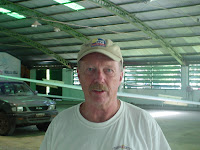WGC2013 report - 16 January
Yesterday proved almost as good as the beautiful sky at launch time suggested it would be. The amazing altitudes promised at the pilot briefing did not materialize - pilots had to be content with 6000 feet instead of 8000. The best lift was close to the forecast - most pilots found some 8-knot climbs. But there were holes to step into, and many pilots wasted at least some time digging out of one or more.
The forecast of overdevelopment and thunderstorms late in the day was spot-on: these grew into formidable obstacles south of Chaves (i.e. just where predicted), and by 6pm a shelf of blowoff had covered the airfield. But even late-arriving pilots were mostly able to find enough altitude north of home to cope with problems on final glide, so the result was lots of finishers and good speeds - the best of the contest so far.
My prediction of a modestly devalued day in Standard class was about right: the best time on course was 2:53, giving the winner (Christophe Cousseau of France) 958 points. A slightly longer task could have worked - but thunderstorms are hard to predict, and I give the Met Office here good marks for coming close yesterday.
All US Team pilots got home. In Standard class, Phil and Peter reported good lift but some long glides under fine-looking clouds that took longer than expected to produce useful lift. Their speeds (just over 102 kph) were good for 15th and 17th place.
Sean and Sarah had good flights in Club class (which in Sean's case included an uncomfortable low point followed by an excellent climb) finishing 11th and 12th. In World class, Tom got low a couple of times and thus was slow, but did manage his first finish of the contest.
A couple of finishes yesterday were noteworthy: two pilots managed a valid finish at a height and speed that left them unable to reach the runway. It appears that one pilot managed this well, with a safe landing into a field of acceptably low crop. The other pilot had difficulties - it appears he almost reached a good field, but with a fence looming in his path came to earth in rather tall corn, producing a groundloop that caused damage to his landing gear. With the attention of some clever local repairmen, he was reported to be ready to fly this morning. (As you've no doubt gathered by now, I find it strange that the finish geometry at a world gliding contest should be arranged to routinely result in risky landouts). [
You're not the only one. Ed.]
As I've noted, we've found roads in Argentina to be generally good, and the "relaxed" enforcement of speed limits well suited to efficient retrieves. There are some differences of note. The normal range of speeds is considerable: big trucks (which are plentiful) do around 80 kph, whereas cars, theoretically limited to 130, may be doing 160. Outside of towns, everyone is supposed to have headlights on (to facilitate safe passing) and to cooperate with overtaking vehicles which includes allowing space for them to duck back into the right lane when passing can't be completed.
In and near towns, watch out for speed bumps, none of which resemble the wimpy US variety: Any speed above about 10 kph risks serious discomfort, derangement of passengers & cargo, and possible suspension damage. It's normal to find that an impromptu detour (itself none too smooth) has been carved out through the dirt shoulder to bypass these. And at city intersections, stop signs are scarce. In rare cases you'll find a traffic light, which may have a surprisingly - not to say painfully - long cycle. More typically you'll find no sign at all - you must negotiate a safe passage with crossing traffic: the nominal rule is that the vehicle on the right has the right-of-way, but the real rule is that the more confident driver in the older vehicle goes first. Fortunately, Argentina drivers in general seem both competent and reasonably courteous.
An interesting feature of glider contests at Chaves is real-time coverage of the finishes by the local radio station. The announcer is good at spotting the oncoming gliders and gets quite excited as they cross the runway threshold and touch down: think of the way a soccer announcer's voice rises as the play gets near the goal and you have the idea.
Here's a sample.
Today's weather started out grim, and stayed there. The few patches of sun on the ground at 8:30 were entirely gone by 9:30. It looked more or less hopeless for soaring, and the weather forecast at the morning pilot briefing said that the only change likely was deterioration: gust fronts and thunderstorms are apparently possible later today and tomorrow. In the face of this we still gridded all gliders and assembled on the runway at 12:15 under leaden skies for the expected series of first launch time postponements. The Puchacz sniffer was unable to stay aloft, and the inevitable day cancellation came around 1:30. This timing proved just right for PG: we towed the glider the short distance from grid to trailer and were sliding the fuselage in the box just as the first raindrops began to fall.


































































